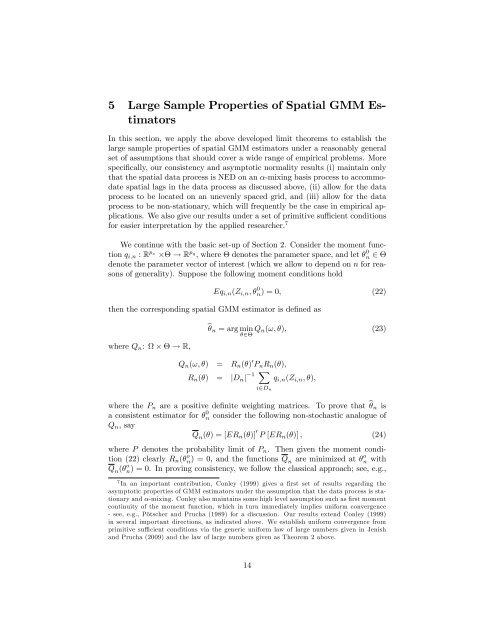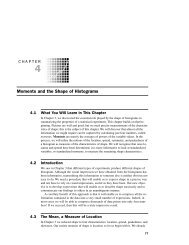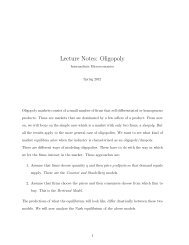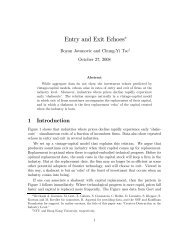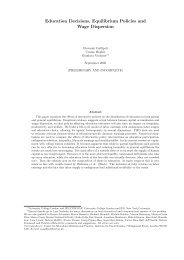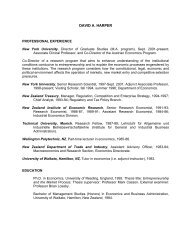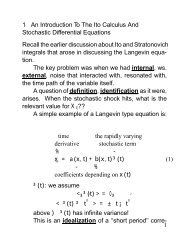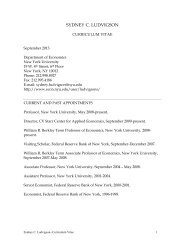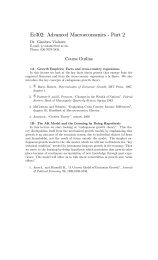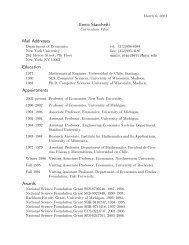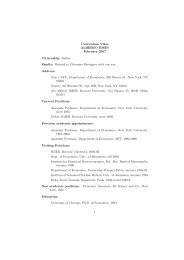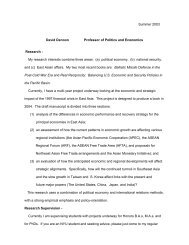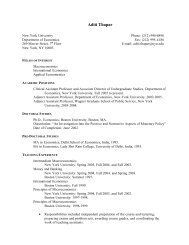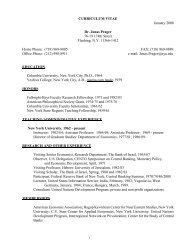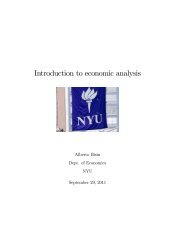On Spatial Processes and Asymptotic Inference under Near$Epoch ...
On Spatial Processes and Asymptotic Inference under Near$Epoch ...
On Spatial Processes and Asymptotic Inference under Near$Epoch ...
Create successful ePaper yourself
Turn your PDF publications into a flip-book with our unique Google optimized e-Paper software.
5 Large Sample Properties of <strong>Spatial</strong> GMM Estimators<br />
In this section, we apply the above developed limit theorems to establish the<br />
large sample properties of spatial GMM estimators <strong>under</strong> a reasonably general<br />
set of assumptions that should cover a wide range of empirical problems. More<br />
speci…cally, our consistency <strong>and</strong> asymptotic normality results (i) maintain only<br />
that the spatial data process is NED on an -mixing basis process to accommodate<br />
spatial lags in the data process as discussed above, (ii) allow for the data<br />
process to be located on an unevenly spaced grid, <strong>and</strong> (iii) allow for the data<br />
process to be non-stationary, which will frequently be the case in empirical applications.<br />
We also give our results <strong>under</strong> a set of primitive su¢ cient conditions<br />
for easier interpretation by the applied researcher. 7<br />
We continue with the basic set-up of Section 2. Consider the moment function<br />
qi;n : R pz ! R pq , where denotes the parameter space, <strong>and</strong> let 0 n 2<br />
denote the parameter vector of interest (which we allow to depend on n for reasons<br />
of generality). Suppose the following moment conditions hold<br />
Eqi;n(Zi;n; 0 n) = 0; (22)<br />
then the corresponding spatial GMM estimator is de…ned as<br />
where Qn: ! R,<br />
b n = arg min<br />
2 Qn(!; ); (23)<br />
Qn(!; ) = Rn( ) 0 PnRn( );<br />
Rn( ) = jDnj<br />
X<br />
1<br />
qi;n(Zi;n; );<br />
i2Dn<br />
where the Pn are a positive de…nite weighting matrices. To prove that b n is<br />
0<br />
a consistent estimator for n consider the following non-stochastic analogue of<br />
Qn, say<br />
Qn( ) = [ERn( )] 0 P [ERn( )] ; (24)<br />
where P denotes the probability limit of Pn. Then given the moment condition<br />
(22) clearly Rn( o o<br />
n) = 0, <strong>and</strong> the functions Qn are minimized at n with<br />
Qn( o n) = 0. In proving consistency, we follow the classical approach; see, e.g.,<br />
7 In an important contribution, Conley (1999) gives a …rst set of results regarding the<br />
asymptotic properties of GMM estimators <strong>under</strong> the assumption that the data process is stationary<br />
<strong>and</strong> -mixing. Conley also maintains some high level assumption such as …rst moment<br />
continuity of the moment function, which in turn immediately implies uniform convergence<br />
- see, e.g., Pötscher <strong>and</strong> Prucha (1989) for a discussion. Our results extend Conley (1999)<br />
in several important directions, as indicated above. We establish uniform convergence from<br />
primitive su¢ cient conditions via the generic uniform law of large numbers given in Jenish<br />
<strong>and</strong> Prucha (2009) <strong>and</strong> the law of large numbers given as Theorem 2 above.<br />
14


